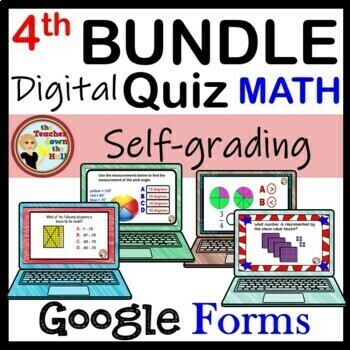Digital Math Assessments I Google Forms Math Quiz 4th Grade Math Centers Bundle
- Google Drive™ folder
- Internet Activities

Products in this Bundle (61)
showing 1-5 of 61 products
Bonus
Description
Need a quick and easy way to assess your students' math skills? This a a bundle of over 50 Google Forms Quizzes each with 20 questions - some multiple choice and some short answer. Send a quiz to your students digitally across any platform, website, or email. Perfect for distance learning, math centers, and even assessments!
New quizzes added:
Perimeter of Irregular Shapes
Use Perimeter to Find Missing Sides
Use Area to Find Missing Sides
- all the above use the Dropdown Answer tool (great practice for
standardized tests!)
✦✦ NOTE: This product is a Google Form quiz. It does NOT include a printable file.
- Google Forms are designed to make your classroom efficient and interactive. This quiz is presented as a self-grading Google Forms that will automatically generate a spreadsheet of student scores, making grading papers a thing of the past. Simply copy and paste the values into your grade book (or link your Google grade book), and your grading is done - making it easier than ever to assess your students' mastery of the standards.
- After submitting responses, students can view their grade, any questions missed, and the correct answers - giving them much needed immediate feedback.
Your students DO NOT need Google to answer this form.
BENEFITS OF THIS RESOURCE:
No Prep
Works on any device
Self-grading
Great for Distance Learning
Immediate Feedback
Detailed DATA!
*****************************************************************************
Other great resources from The Teacher Down the Hall:
Follow The Teacher Down the Hall for notifications of new products and special sales!





